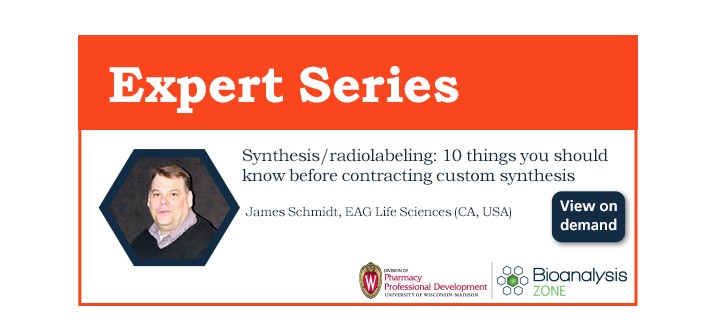Expert Series: Synthesis /radiolabeling: 10 things you should know before contracting custom synthesis

Speaker: James Schmidt
James Schmidt is the EAG Life Sciences Senior Scientific Advisor for Custom Synthesis, Trace Analysis and Structural Chemistry, and Product Chemistry.
Jim attended Benedictine College (Atchison, KS) where he studied chemistry and philosophy; he received his B.S. in Chemistry (ACS Certified) from the University of Central Oklahoma and completed supporting graduate work in environmental impact assessment at the University of Oklahoma.
Jim brings nearly three decades of experience in xenobiotic metabolism, bio-analytical chemistry, and structural elucidation with private, government, and industrial laboratories, with positions at the USEPA’s Kerr Groundwater Research Laboratory (Ada, OK), Sandoz Agro (Des Plaines, IL), Abbott Laboratories (Abbott Park, IL), Lexicon Pharmaceuticals (The Woodlands, TX), and presently as a Sr. Scientific Advisor (SSA) at ABC Labs (Columbia, MO).
His special interests include small molecule metabolic stability, metabolite profiling and identification, chiral separations, and pharmacologically active metabolites. He is the author or co-author of several peer-reviewed posters and papers, as well as innumerable scientific reports to satisfy regulatory requirements of both the EPA and FDA. Most recently, he contributed the chapter on “Metabolite Profiling” to the book New Horizons in Predictive Drug Metabolism and Pharmacokinetics (Alan G. E Wilson, ed., RSC Publishing, 2015). Jim is based at EAG’s Columbia, Missouri (formerly ABC Laboratories) location.
In this webinar, Jim Schmidt talks about the 10 things you should know before contracting custom synthesis. He explains how companies often need to arrange for the synthesis of test substances to support research and development efforts. Synthesized test materials range from active ingredients, intermediates, fine chemicals and reference standards to impurities and metabolites. Depending on the type and depth of data required, custom synthesized materials may need to be radiolabeled, stable-labeled or non-radiolabeled; and depending on the type of study, a GxP manufacturing environment may be necessary. There are many important decisions to consider before proceeding with a contract for custom synthesis.
Here, he addresses communication, regulatory requirements, strategic use of isotopes, position of radiolabel, timing; scalability; re-purification/characterization; metabolite and impurity reference standards; analytical support; intellectual property and more.
Following this webinar, you will have a better understanding of:
There are a number of important decisions to consider before proceeding with a contract for synthesis. An adaptation of the “Five W’s” for gathering information and problem solving – Who, What, When, Where, and Why – provides a good start:
Who – Who do you need to talk to about your synthesis project? That depends very much on your specific needs and scale, which can range from small quantities of a reference standard to support a bio-analytical project to much larger amounts of API to support a clinical trial. The quality agreements, production systems, and contracting arrangements are quite different across that range. For large scale projects, you will want to consult with a large-scale Contract Manufacturing Organization (CMO).
This white paper provides advice and guidance to those with the responsibility of procuring the milligram to multi-gram amounts of reference standards, internal standards, impurities, or radiolabeled materials produced by custom synthesis vendors.
What – 14C or 3H for a metabolism study? 12C for a reference standard? 13C, 2H, or 15N for an internal standard?
When – It’s important to allow sufficient lead time for the procurement of starting material, the actual synthesis, and any other deliverables (such as a Certificate of Analysis). As the complexity of a synthetic scheme increases, whether in chemistry or steps, so does the time required. Timing also will depend on the regulatory approach: for example, CGMP synthesis will take significantly longer than a non-regulatory project.
Where – For radioactive materials, especially, it’s important to decide where on the molecule the label should be incorporated. This can sometimes require the design of a new synthetic pathway. Depending on the molecule, radiolabeling in multiple positions – or the strategic use of multiple isotopes – may assist in defining the metabolic pathway.
Why – It’s last in the Five W’s, but this should always be the first question you ask before proceeding with a custom synthesis. Good study design should always come first to avoid complications later. Is the test substance to be used in humans or in preclinical species? Is the material needed for tracking degradation in plants, animals, and/or environmental matrices?
For more webinars from our expert series click here
